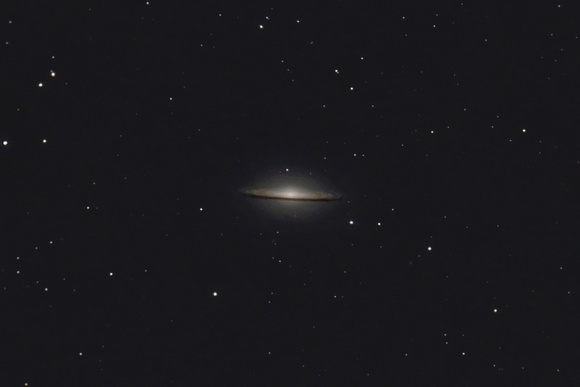Canon 350D Hap Griffin Baader Mod14x180sec at iso 1600
30 Darks/Flats/Bias
Celestron 9.25 reduced 0.63Astroimaging Challenge Yahoo Group Winner April, 2008
I really like the "oil painting" appearance that happened to come out of the processing of this image. I think it adds to the mystery of a very enigmatic object.
The "Sombrero" is located in the constellation Virgo, at a distance of about 50 million light-years. This galaxy is notable for its dominant nuclear bulge, composed primarily of mature stars, and its nearly edge-on disk composed of stars, gas, and intricately structured dust. The complexity of this dust, and the high resolution of this image, is most apparent directly in front of the bright nucleus, but is also very evident as dark absorbing lanes throughout the disk.
M104's most striking feature is the dust lane that crosses in front of the bulge of the galaxy. This dust lane is actually a symmetric ring that encloses the bulge of the galaxy. Most of the cold atomic hydrogen gas and the dust lies within this ring. The ring might also contain most of the Sombrero Galaxy's cold molecular gas, although this is an inference based on observations with low resolution and weak detections. Additional observations are needed to confirm that the Sombrero galaxy's molecular gas is constrained to the ring. Based on infrared spectroscopy, the dust ring is the primary site of star formation within this galaxy.
In the 1990s, research demonstrated that a supermassive black hole is present within the Sombrero Galaxy. Using spectroscopy data from both the CFHT and the Hubble Space Telescope, the group showed that the speed of rotation of the stars within the center of the galaxy could not be maintained unless a mass 1 billion times the mass of the Sun is present in the center. This is among the most massive black holes measured in any nearby galaxies.
The Sombrero Galaxy lies within a complex, filament-like cloud of galaxies that extends to the south of the Virgo Cluster. However, it is unclear as to whether the Sombrero Galaxy is part of a formal galaxy group. Hierarchical methods for identifying groups, which determine group membership by considering whether individual galaxies belong to a larger aggregate of galaxies, typically produce results showing that the Sombrero Galaxy is part of a group that includes NGC 4487, NGC 4504, NGC 4802,


